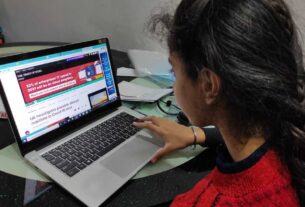The Indian smartwatch market witnessed its strongest year-on-year (YOY) growth of 364.1 percent in 2021, but users need to draw the line at depending on them medically.
With the adoption of smart watches skyrocketing, scientists are calling for further research into how to use them to monitor oxygen levels. Doctors are also skeptical of their accuracy, stating that too much reliance on technology could be harmful.
Siva Ram Nyapathi, a technology enthusiast and an information technology (IT) engineer, said that even the medical instruments we use like glucometers are not accurate. Smart watches might not exactly be validated by research but it is almost equal to fingertip pulse oximetry.
“When I had corona, I was monitoring it using both smart watches as well a pulse oximeter. As far as my memory goes, it gave the same result,” he said.Dr Madhusudhan K a senior resident at JSS University, Mysore, Karnataka, said that both use outdated technology.
He added that pulse oximetry or smartwatches should be used only in emergencies to monitor oxygen levels. Once oxygen levels dropped below 88 percent, it was very dangerous to use this equipment.
He said, “It is too risky for my patients because I’m not working in data science, where there is an opportunity to go back, analyse and correct an error. Medical science is all or none. It is a human life, if data is wrong then the patient dies and that’s it. Even today, I use manual blood pressure apparatus to check my patients because I will never be happy with digital data if it does not correlate with historical data. Everyday I see many patients die due to over-dependence on technological data.”
In a research paper published by the Lancet, scientists asked for clarifications on acceptable accuracy and standardised validation procedures to measure peripheral arterial oxygen saturation (SpO2) through smart watches. Monitoring SpO2 became popular during the COVID-19 pandemic. It can be measured using fingertip pulse oximetry. Since 2021, popular smart watches produced by Apple, Samsung, Huawei, Garmin, Fitbit, and others have also integrated the function of measuring SpO2 using the reflectance photoplethysmography (R-PPG) method—similar to pulse oximetry.
In Feburary 2021,The US Food and Drug Administration (FDA) had warned about inaccuracies in measuring SpO2 using consumer-grade fingertip pulse oximeters. Smart watches (which use the same technology) were not included in this statement only because the SpO2 measurement feature was not available to them at that time.
None of the smartwatch companies had their product’s validity tested against the invasive arterial blood gas (ABG), a test which is considered the gold standard to access SpO2 accuracy in lab conditions.
Dr Madhusudhan said that the ABG test measures real-time oxygen and carbon dioxide levels in the blood as well blood potential hydrogen (pH) balance. It is considered the gold standard because it gives information about gas levels at the cellular level. He added “I don’t think whatever research they do without using invasive techniques can be of help. As we can’t get gas levels at cellular levels without such techniques.”
Smartwatches can help with motivation to achieve fitness goals. Siva said that his watch collects data and syncs it to the fitness tracker application, Google Fit. Further, it also syncs it to an Android application called stridekick. All his teammates have it installed and they compete with each other.
He uses his smartwatch whenever he exercises on the treadmill. “I try to keep my oxygen levels in anaerobic mode to get a better workout,” he said. His watch has five modes —Lite, intensive, aerobic, anaerobic and O2 max. They are calculated based on the heartbeat and oxygen (O2) saturation.
Dr Madhusudhan also highlighted some of the uses of a smartwatch. He added that pulse rate and sleep monitoring in smartwatches can be beneficial. These two data, if used correctly, can change the landscape of our healthcare system. But for oxygen levels, “it is just a bonus and not at all accurate,” he said.
During the pandemic, when the wearables market was seeing a decline, Apple Watch still saw great sales. It accounted for more than half of global smartwatch market sales. The company’s focus with its smartwatch was health and fitness. Its biggest talking point was SpO2 monitoring.
The Indian smart watch market witnessed its strongest on-year growth of 364.1 percent in 2021. As per a report by International Data Corporation (IDC) 23.8 million wearables were sold in India in the third quarter. Smartwatches were amongst the fastest-growing category with 4.3 million shipments and on-year growth of 271.2 percent.
Dr Madhusudhan said that the medical field is a dynamic science which needs past historical data, present historical data and technology data. With them, future data can be predicted. But without historical data and over dependence on technological data and forward-looking science humanity will not survive.
He added that many studies showed unnecessary intervention and over diagnosis have killed more patients than under diagnosis. “Our healthcare should be patient-centric, not technology-centric which is not accessible, affordable and not sustainable,” he said.




